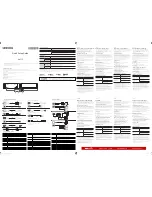
EO Abator Operation and Installation Manual
13
from the sterilizer to the EO Abator system. Use flanged or compression fittings at the sterilizer outlet. Braze or solder all
the other line fittings. For additional information refer to the 3M Steri-Vac installation guide.
Length and Diameter of Vent Line (XL Series)
Number of Sterilizers
(XL Series)
Length < 31m (100 ft.)
31m (100 ft) ≤ length < 61m
(200 ft)
61m (200 ft) ≤ length ≤
91.5m (300 ft)
1
1.9 cm (3/4 inch)
1.9 cm (3/4 inch)
1.9 cm (3/4 inch)
2
1.9 cm (3/4 inch)
2.5 cm (1.0 inch)
2.5 cm (1.0 inch)
Length and Diameter of Vent Line (GS Series)
Number of Sterilizers
(GS Series)
Length < 31m (100 ft.)
31m (100 ft) ≤ length < 61m
(200 ft)
61m (200 ft) ≤ length ≤
91.5m (300 ft)
1
2.5 cm (1.0 inch)
2.5 cm (1.0 inch)
2.5 cm (1.0 inch)
2
2.5 (1.0 inch)
3.8 cm (1.5 inch)
3.8 cm (1.5 inch)
Table 1.
Safety Vent Line Requirements
The EO Abator system is equipped with a safety vent port to vent EO to the atmosphere in the event of an EO Abator
system malfunction. Connect a safety vent line to the 1.9 cm (¾ in.) NPT port using properly sized O.D. copper tubing.
Install 180º elbow (turned down) with a “bug screen” at the end of the line. Refer to Table 1 for determining proper line
size based upon the combined length of both safety vent and EO inlet lines. Note: Adapters may be required.
The safety vent line could contain significant amounts of Ethylene Oxide in the event of a system malfunction.
Do not terminate the line within 8 M (25 ft.) of any possible sources of ignition or any opening to the building interior
such as fresh air inlets, unsealed windows, or pedestrian traffic areas. Keep all of the vent line, with the exception of
a turned down extension terminating on the roof top or exterior wall, inside the building. This prevents moisture from
freezing in the line and blocking the vent. For additional information refer to the appropriate (XL Series or GS Series) 3M
Steri-Vac Sterilizer Site Planning and Installation Guide.
Exhaust System Requirements
The temperature of the air exhaust from the EO Abator can be as high as 260°C (500°F). The EO Abator exhaust
can contain low concentrations of EO, typically less than 2.5 PPM.
The EO Abator exhaust must be connected to a
dedicated exhaust system supplied by the customer.
Note: There are two exhaust ducting arrangements that can be
used (see Figure 1).
Arrangement 1
The EO Abator exhaust is mixed with room air in a negative pressure duct. The advantage of this arrangement is
that all leaks are into the duct. The dedicated duct used for the sterilizer hood (if the sterilizer is equipped with
a hood) may be used for this arrangement if the ducting and blower is sized to handle the extra 5.66 m
3
/min
(200 ft
3
/min) of air required for the EO Abator. For 5XL or 8XL, use the information in the 3M Steri-Vac XL Series
Site Planning and Installation Manual (78-8078-8490-9) and for the GS Series sterilizers use the information
in the 3M Steri-Vac GS Series Site Planning and Installation Guide (78-8083-3481-3) for ducting and blower
installation.
This arrangement requires an air mixing valve that is attached to the EO Abator exhaust. Air mixing valve (part
number 78-8078-9814-9) is available through the 3M Health Care Service Center. Connect the air mixing valve
to the EO Abator exhaust flange using high temperature RTV to seal the flanges, then tighten flange clamp (part
number 78-8069-7474-3) to lock the parts together. Connect the outlet of the air mixing valve 152 mm (6 in.) O.D.
to the duct system with 152 mm (6 in.) metallic ducting (Figures 1 and 8). An airflow damper will be required in the
152 mm (6 in.) duct downstream of the mixing valve to balance the airflow between the EO Abator and the hood
duct system. The airflow in the 152 mm (6 in.) duct must be maintained between 5.66-7.08 m
3
/min
(200-250ft
3
/min) with the EO Abator running and the “abator ready” light illuminated.












































